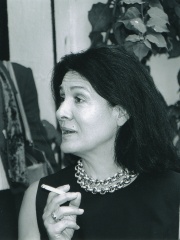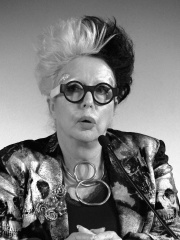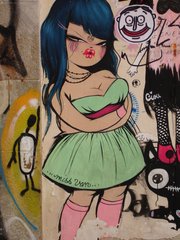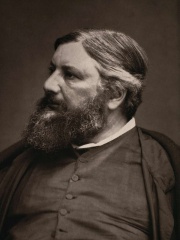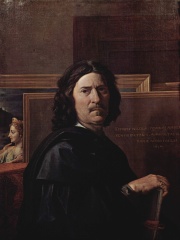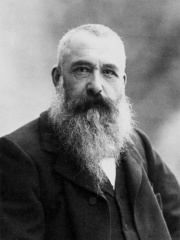
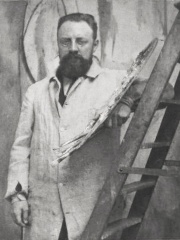
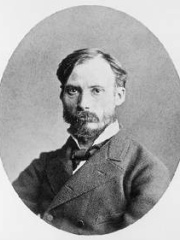
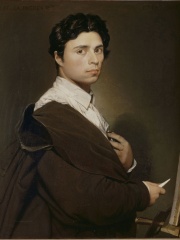
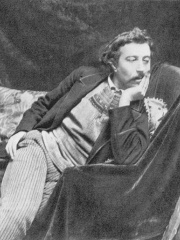
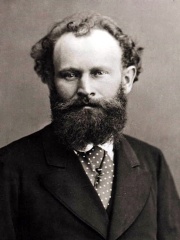
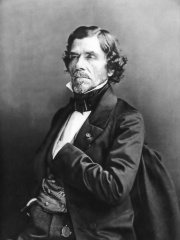
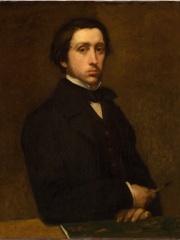
The Most Famous
PAINTERS from France
Top 10
The following people are considered by Pantheon to be the top 10 most legendary French Painters of all time. This list of famous French Painters is sorted by HPI (Historical Popularity Index), a metric that aggregates information on a biography's online popularity. Visit the rankings page to view the entire list of French Painters.

1. Claude Monet (1840 - 1926)
With an HPI of 88.69, Claude Monet is the most famous French Painter. His biography has been translated into 131 different languages on wikipedia.
Oscar-Claude Monet (UK: , US: ; French: [klod mɔnɛ]; 14 November 1840 – 5 December 1926) was a French painter and founder of Impressionism who is seen as a key precursor to modernism, especially in his attempts to paint nature as he perceived it. During his long career, he was the most consistent and prolific practitioner of Impressionism's philosophy of expressing one's perceptions of nature, especially as applied to plein air (outdoor) landscape painting. The term "Impressionism" is derived from the title of his painting Impression, Sunrise (Impression, soleil levant), which was exhibited in 1874 at the First Impressionist Exhibition, initiated by Monet and a number of like-minded artists as an alternative to the Salon. Monet was raised in Le Havre, Normandy, and became interested in the outdoors and drawing from an early age. Although his mother, Louise-Justine Aubrée Monet, supported his ambitions to be a painter, his father, Claude-Adolphe, disapproved and wanted him to pursue a career in business. He was very close to his mother, but she died in January 1857 when he was sixteen years old, and he was sent to live with his childless, widowed but wealthy aunt, Marie-Jeanne Lecadre. He went on to study at the Académie Suisse, and under the academic history painter Charles Gleyre, where he was a classmate of Auguste Renoir. His early works include landscapes, seascapes, and portraits, but attracted little attention. A key early influence was Eugène Boudin, who introduced him to the concept of plein air painting. From 1883, Monet lived in Giverny, also in northern France, where he purchased a house and property and began a vast landscaping project, including a water-lily pond. Monet's ambition to document the French countryside led to a method of painting the same scene many times so as to capture the changing of light and the passing of the seasons. Among the best-known examples are his series of haystacks (1890–1891), paintings of Rouen Cathedral (1892–1894), and the paintings of water lilies in his garden in Giverny, which occupied him for the last 20 years of his life. Frequently exhibited and successful during his lifetime, Monet's fame and popularity soared in the second half of the 20th century when he became one of the world's most famous painters and a source of inspiration for a burgeoning group of artists.

2. Henri Matisse (1869 - 1954)
With an HPI of 86.28, Henri Matisse is the 2nd most famous French Painter. His biography has been translated into 151 different languages.
Henri Émile Benoît Matisse (French: [ɑ̃ʁi emil bənwa matis]; 31 December 1869 – 3 November 1954) was a French visual artist, known for both his use of colour and his fluid and original draughtsmanship. He was a draughtsman, printmaker, and sculptor, but is known primarily as a painter. Matisse is commonly regarded, along with Pablo Picasso, as one of the artists who best helped to define the revolutionary developments in the visual arts throughout the opening decades of the twentieth century, responsible for significant developments in painting and sculpture. The intense colourism of the works he painted between 1900 and 1905 brought him notoriety as one of the Fauves (French for "wild beasts"). Many of his finest works were created in the decade or so after 1906, when he developed a rigorous style that emphasized flattened forms and decorative pattern. In 1917, he relocated to a suburb of Nice on the French Riviera, and the more relaxed style of his work during the 1920s gained him critical acclaim as an upholder of the classical tradition in French painting. After 1930, he adopted a bolder simplification of form. When ill health in his final years prevented him from painting, he created an important body of work in the medium of cut paper collage. His mastery of the expressive language of colour and drawing, displayed in a body of work spanning over a half-century, won him recognition as a leading figure in modern art.

3. Pierre-Auguste Renoir (1841 - 1919)
With an HPI of 86.02, Pierre-Auguste Renoir is the 3rd most famous French Painter. His biography has been translated into 96 different languages.
Pierre-Auguste Renoir (; French: [pjɛʁ oɡyst ʁənwaʁ]; 25 February 1841 – 3 December 1919) was a French artist who was a leading painter in the development of the Impressionist style. It has been said that, as a celebrator of beauty and especially feminine sensuality, "Renoir is the final representative of a tradition which runs directly from Rubens to Watteau." He was the father of the actor Pierre Renoir (1885–1952), the filmmaker Jean Renoir (1894–1979) and the ceramic artist Claude Renoir (1901–1969). He was the grandfather of the filmmaker Claude Renoir (1913–1993), son of Pierre.

4. Jean-Auguste-Dominique Ingres (1780 - 1867)
With an HPI of 85.42, Jean-Auguste-Dominique Ingres is the 4th most famous French Painter. His biography has been translated into 121 different languages.
Jean-Auguste-Dominique Ingres ( ANG-grə; French: [ʒɑ̃ oɡyst dɔminik ɛ̃ɡʁ]; 29 August 1780 – 14 January 1867) was a French Neoclassical painter. Ingres was profoundly influenced by past artistic traditions and aspired to become the guardian of academic orthodoxy against the ascendant Romantic style. Although he considered himself a painter of history in the tradition of Nicolas Poussin and Jacques-Louis David, it is his portraits, both painted and drawn, that are recognized as his greatest legacy. His expressive distortions of form and space made him an important precursor of modern art, influencing Henri Matisse, Pablo Picasso, and other modernists. Born into a modest family in Montauban, he travelled to Paris to study in the studio of David. In 1802 he made his Salon debut, and won the Prix de Rome for his painting The Ambassadors of Agamemnon in the tent of Achilles. By the time he departed in 1806 for his residency in Rome, his style—revealing his close study of Italian and Flemish Renaissance masters—was fully developed, and would change little for the rest of his life. While working in Rome and subsequently Florence from 1806 to 1824, he regularly sent paintings to the Paris Salon, where they were faulted by critics who found his style bizarre and archaic. He received few commissions during this period for the history paintings he aspired to paint, but was able to support himself and his wife as a portrait painter and draughtsman. He was finally recognized at the Salon in 1824, when his Raphaelesque painting, The Vow of Louis XIII, was met with acclaim, and Ingres was acknowledged as the leader of the Neoclassical school in France. Although the income from commissions for history paintings allowed him to paint fewer portraits, his Portrait of Monsieur Bertin marked his next popular success in 1833. The following year, his indignation at the harsh criticism of his ambitious composition The Martyrdom of Saint Symphorian caused him to return to Italy, where he assumed directorship of the French Academy in Rome in 1835. He returned to Paris for good in 1841. In his later years he painted new versions of many of his earlier compositions, a series of designs for stained glass windows, several important portraits of women, and The Turkish Bath, the last of his several Orientalist paintings of the female nude, which he finished at the age of 83.
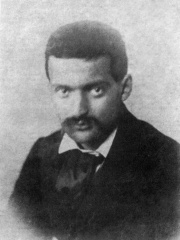
5. Paul Cézanne (1839 - 1906)
With an HPI of 85.32, Paul Cézanne is the 5th most famous French Painter. His biography has been translated into 112 different languages.
Paul Cézanne ( say-ZAN, UK also siz-AN, US also say-ZAHN; French: [pɔl sezan]; Occitan: Pau Cesana; 19 January 1839 – 22 October 1906) was a French Post-Impressionist painter whose work introduced new modes of representation, influenced avant-garde artistic movements of the early 20th century and formed the bridge between late 19th-century Impressionism and early 20th-century Cubism. While his early works were influenced by Romanticism—such as the murals in the Jas de Bouffan country house—and Realism, Cézanne arrived at a new pictorial language through intense examination of Impressionist forms of expression. He altered conventional approaches to perspective and broke established rules of academic art by emphasizing the underlying structure of objects in a composition and the formal qualities of art. Cézanne strived for a renewal of traditional design methods on the basis of the impressionistic colour space and colour modulation principles. Cézanne's often repetitive, exploratory brushstrokes are highly characteristic and clearly recognizable. He used planes of colour and small brushstrokes that build up to form complex fields. The paintings convey Cézanne's intense study of his subjects. His painting initially provoked incomprehension and ridicule in contemporary art criticism. Until the late 1890s it was mainly fellow artists such as Camille Pissarro and the art dealer and gallery owner Ambroise Vollard who discovered Cézanne's work and were among the first to buy his paintings. In 1895, Vollard opened the first solo exhibition in his Paris gallery, which led to a broader examination of Cézanne's work. Both Henri Matisse and Pablo Picasso are said to have remarked that Cézanne "is the father of us all".

6. Paul Gauguin (1848 - 1903)
With an HPI of 85.15, Paul Gauguin is the 6th most famous French Painter. His biography has been translated into 111 different languages.
Eugène Henri Paul Gauguin (; French: [øʒɛn ɑ̃ʁi pɔl ɡoɡɛ̃]; 7 June 1848 – 8 May 1903) was a French painter, sculptor, printmaker, ceramist, and writer, whose work has been primarily associated with the Post-Impressionist and Symbolist movements. He was also an influential practitioner of wood engraving and woodcuts as art forms. While only moderately successful during his lifetime, Gauguin has since been recognized for his experimental use of color and Synthetist style that were distinct from Impressionism. Gauguin was born in Paris in 1848, amidst the tumult of Europe's revolutionary year. In 1850, Gauguin's family settled in Peru, where he experienced a privileged childhood that left a lasting impression on him. Later, financial struggles led them back to France, where Gauguin received formal education. Initially working as a stockbroker, Gauguin started painting in his spare time, his interest in art kindled by visits to galleries and exhibitions. The financial crisis of 1882 significantly impacted his brokerage career, prompting a shift to full-time painting. Gauguin's art education was largely self-taught and informal, shaped significantly by his associations with other artists rather than academic training. His entry into the art world was facilitated by his acquaintance with Camille Pissarro, a leading Impressionist. Pissarro took on a mentor role for Gauguin, introducing him to other Impressionist artists and techniques. He exhibited with the Impressionists in the early 1880s, but soon began developing his distinct style, characterized by a bolder use of color and less traditional subject matter. His work in Brittany and Martinique showcased his inclination towards depicting native life and landscapes. By the 1890s, Gauguin's art took a significant turn during his time in Tahiti, then a French colony, where he sought a refuge from the Western civilization. Gauguin's later years in Tahiti and the Marquesas Islands were marked by health problems and financial struggles. His paintings from that period, characterized by vivid colors and Symbolist themes, would prove highly successful among the European viewers for their exploration of the relationships between people, nature, and the spiritual world. Gauguin's art became popular after his death, partially from the efforts of dealer Ambroise Vollard, who organized exhibitions of his work late in his career and assisted in organizing two important posthumous exhibitions in Paris. His work was influential on the French avant-garde and many modern artists, such as Pablo Picasso and Henri Matisse, and he is well known for his relationship with Vincent and Theo van Gogh.

7. Édouard Manet (1832 - 1883)
With an HPI of 84.08, Édouard Manet is the 7th most famous French Painter. His biography has been translated into 99 different languages.
Édouard Manet (UK: , US: ; French: [edwaʁ manɛ]; 23 January 1832 – 30 April 1883) was a French modernist painter. He was one of the first 19th-century artists to paint modern life, as well as a pivotal figure in the transition from Realism to Impressionism. Born into an upper-class household with strong political connections, Manet rejected the naval career originally envisioned for him; he became engrossed in the world of painting. His early masterworks, The Luncheon on the Grass (Le déjeuner sur l'herbe) and Olympia, premiering in 1863 and '65, respectively, caused great controversy with both critics and the Academy of Fine Arts, but soon were praised by progressive artists as the breakthrough acts to the new style, Impressionism. These works, along with others, are considered watershed paintings that mark the start of modern art. The last 20 years of Manet's life saw him form bonds with other great artists of the time; he developed his own simple and direct style that would be heralded as innovative and serve as a major influence for future painters.

8. Eugène Delacroix (1798 - 1863)
With an HPI of 83.92, Eugène Delacroix is the 8th most famous French Painter. His biography has been translated into 93 different languages.
Ferdinand Victor Eugène Delacroix ( DEL-ə-krwah, -KRWAH; French: [øʒɛn dəlakʁwa]; 26 April 1798 – 13 August 1863) was a French Romantic artist who was regarded as the leader of the French Romantic school. In contrast to the Neoclassical perfectionism of his chief rival Ingres, Delacroix took for his inspiration the art of Rubens and painters of the Venetian Renaissance, with an attendant emphasis on colour and movement rather than clarity of outline and carefully modelled form. Dramatic and romantic content characterized the central themes of his maturity, and led him not to the classical models of Greek and Roman art, but to travel in North Africa, in search of the exotic. Friend and spiritual heir to Théodore Géricault, Delacroix was also inspired by Lord Byron, with whom he shared a strong identification with the "forces of the sublime", of nature in often violent action. However, Delacroix was given to neither sentimentality nor bombast, and his Romanticism was that of an individualist. In the words of Baudelaire, "Delacroix was passionately in love with passion, but coldly determined to express passion as clearly as possible." Together with Ingres, Delacroix is considered one of the last old Masters of painting and is one of the few who was ever photographed. As a painter and muralist, Delacroix's use of expressive brushstrokes and his study of the optical effects of colour profoundly shaped the work of the Impressionists, while his passion for the exotic inspired the artists of the Symbolist movement. A fine lithographer, Delacroix illustrated various works of William Shakespeare, the Scottish author Walter Scott, and the German author Johann Wolfgang von Goethe.

9. Edgar Degas (1834 - 1917)
With an HPI of 82.47, Edgar Degas is the 9th most famous French Painter. His biography has been translated into 94 different languages.
Edgar Degas (UK: , US: ; born Hilaire-Germain-Edgar De Gas, French: [ilɛːʁ ʒɛʁmɛ̃ ɛdɡaʁ də ɡa]; 19 July 1834 – 27 September 1917) was a French Impressionist artist famous for his pastel drawings and oil paintings. Degas also produced bronze sculptures, prints, and drawings. Degas is especially identified with the subject of dance; more than half of his works depict dancers. Although Degas is regarded as one of the founders of Impressionism, he rejected the term, preferring to be called a realist, and did not paint outdoors as many Impressionists did. Degas was a superb draftsman, and particularly masterly in depicting movement, as can be seen in his rendition of dancers and bathing female nudes. In addition to ballet dancers and bathing women, Degas painted racehorses and racing jockeys, as well as portraits. His portraits are notable for their psychological complexity and their portrayal of human isolation. At the beginning of his career, Degas wanted to be a history painter, a calling for which he was well prepared by his rigorous academic training and close study of classical Western art. In his early thirties he changed course, and by bringing the traditional methods of a history painter to bear on contemporary subject matter, he became a classical painter of modern life.
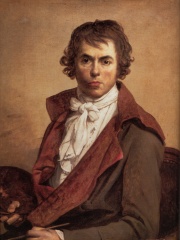
10. Jacques-Louis David (1748 - 1825)
With an HPI of 82.11, Jacques-Louis David is the 10th most famous French Painter. His biography has been translated into 85 different languages.
Jacques-Louis David (French: [ʒaklwi david]; 30 August 1748 – 29 December 1825) was a French painter in the Neoclassical style, considered to be the preeminent painter of the era. In the 1780s, his cerebral brand of history painting marked a change in taste away from Rococo frivolity toward classical austerity, severity, and heightened feeling, which harmonized with the moral climate of the final years of the Ancien Régime. David later became an active supporter of the French Revolution and friend of Maximilien Robespierre (1758–1794), and was effectively a dictator of the arts under the French Republic. Imprisoned after Robespierre's fall from power, he aligned himself with yet another political regime upon his release: that of Napoleon, the First Consul of France. At this time he developed his Empire style, notable for its use of warm Venetian colours. After Napoleon's fall from Imperial power and the Bourbon revival, David exiled himself to Brussels, then in the United Kingdom of the Netherlands, where he remained until his death. David had many pupils, making him the strongest influence in French art of the early 19th century, especially academic Salon painting.
People
Pantheon has 264 people classified as French painters born between 1330 and 1983. Of these 264, 5 (1.89%) of them are still alive today. The most famous living French painters include Paloma Picasso, Orlan, and Joana Vasconcelos. The most famous deceased French painters include Claude Monet, Henri Matisse, and Pierre-Auguste Renoir. As of April 2024, 2 new French painters have been added to Pantheon including JR, and Miss Van.
Living French Painters
Go to all RankingsPaloma Picasso
1949 - Present
HPI: 65.52
Orlan
1947 - Present
HPI: 59.54
Joana Vasconcelos
HPI: 49.65
JR
1983 - Present
HPI: 44.81
Miss Van
1973 - Present
HPI: 42.12
Deceased French Painters
Go to all RankingsClaude Monet
1840 - 1926
HPI: 88.69
Henri Matisse
1869 - 1954
HPI: 86.28
Pierre-Auguste Renoir
1841 - 1919
HPI: 86.02
Jean-Auguste-Dominique Ingres
1780 - 1867
HPI: 85.42
Paul Cézanne
1839 - 1906
HPI: 85.32
Paul Gauguin
1848 - 1903
HPI: 85.15
Édouard Manet
1832 - 1883
HPI: 84.08
Eugène Delacroix
1798 - 1863
HPI: 83.92
Edgar Degas
1834 - 1917
HPI: 82.47
Jacques-Louis David
1748 - 1825
HPI: 82.11
Gustave Courbet
1819 - 1877
HPI: 81.84
Nicolas Poussin
1594 - 1665
HPI: 81.04
Newly Added French Painters (2025)
Go to all RankingsOverlapping Lives
Which Painters were alive at the same time? This visualization shows the lifespans of the 25 most globally memorable Painters since 1700.

